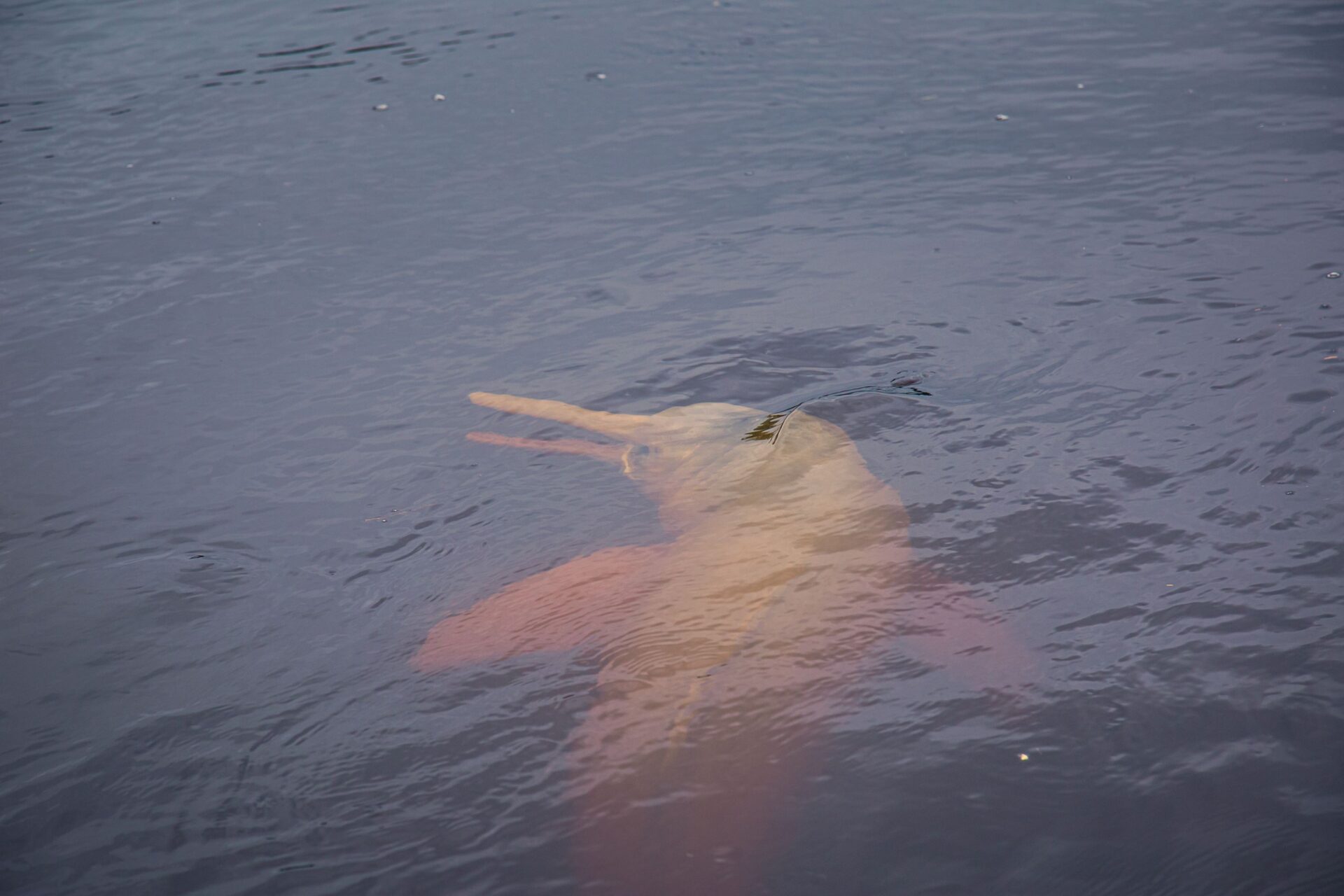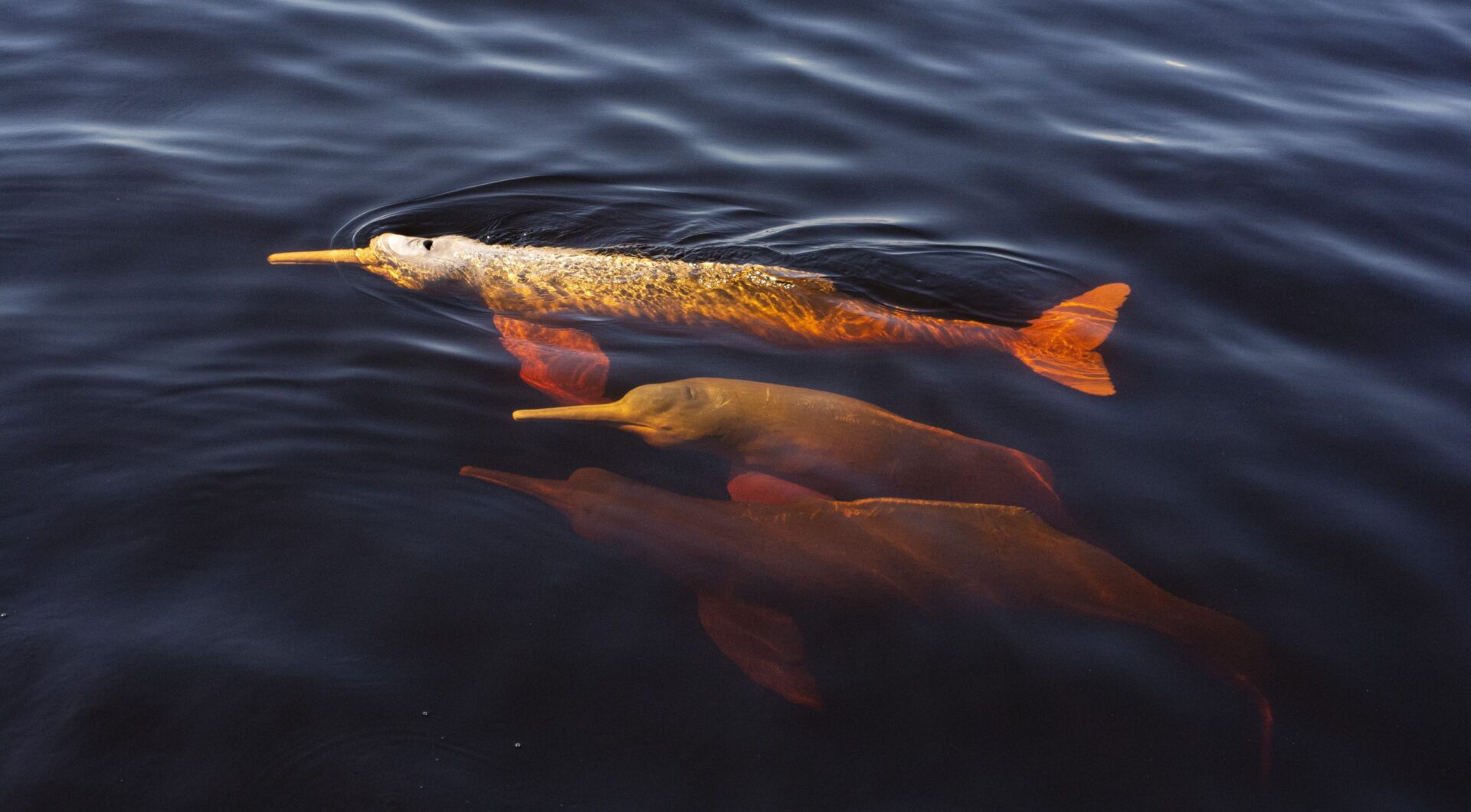
Shrouded in folklore, the Amazon River Dolphin is one of Ecuador’s most unusual residents. Credit: Sebastián Benalcazar/Nature and Culture International
In the murky waters of the Amazon, the Amazon River Dolphin (Inia geoffrensis) once reigned supreme. Today, it is rapidly disappearing, pushed towards the brink by human activity. With our autumn appeal, Protecting the Ecuadorian Amazon, you can support our partner Nature and Culture in Ecuador to turn its future around.
Thousands of miles from the sea, an unlikely animal swims through the Amazon’s tangled mass of rivers, creeks, and tributaries, breaking the water’s surface only as it rises to breathe. With its cylindrical body, beak-like snout, and irrepressible curiosity, it is clearly a dolphin, but an unusual one. Among other things, it has pink skin, a large melon-like forehead and a very shrunken dorsal fin. 15 million years of evolution have clearly left their mark.

Living in the Amazon requires a host of characteristics not seen in marine dolphins. These include enlarged pelvic fins and extreme flexibility. Credit: Sebastián Benalcazar/Nature and Culture International
Life in the Amazon basin is radically different from life in the open ocean. In the Amazon, dolphins have few natural predators and are surrounded by an abundance of prey. This negates the need for the large cooperative pods found out at sea and so they are much less social, often seen in groups numbering no more than three to four.

The Amazon River Dolphin (Inia geoffrensis) has many neighbours but few friends and lives in small pods. Credit: Silvio Batista Piotto Junior/Wikimedia Commons
Unlike the ocean, the Amazon is a dense maze of submerged branches. Navigating this obstacle-strewn environment requires supreme agility and for this, Amazon River Dolphins have unfused neck vertebrae and very large pelvic fins. Like their marine cousins, they find their prey with echolocation but, here, where the river channels are shallower and smaller, they use quieter clicks to prevent an overwhelming cacophony of returning echoes.
But why pink?
Their Barbie-like skin tone is still poorly understood. Several factors are likely responsible, including genetics, a diet rich in carotenoids (the same pigment that gives salmon their pink hue), and scarring from fights. What is known is that all Amazon River Dolphins are born grey and then slowly acquire their pink skin tone as they age.

Why the Amazon River Dolphin is pink remains a mystery. Numerous explanations abound, from a diet rich in carotenoids to river battle scars. Credit: Sebastián Benalcazar/Nature and Culture International
Old folktales and an uncertain future
In the remote settlements along the Amazon, stories have been told about the Amazon River Dolphin, locally called the boto, for many years. Strange tales of a seductive shapeshifter, an Encantado, who transforms into an irresistible young man by night, uses his charms at local parties, and then vanishes into the river as day breaks. Or tales of people kidnapped underwater to a magical Atlantis-like world from which no one ever returns. To this day, some fishermen will avoid meeting a boto’s eye in case it gives them a lifetime of nightmares. An even worse fate is said to befall anyone who dares to maim a boto or eat its flesh.
But this is beginning to change. Declining beliefs in the old folktales together with an increasing human population is increasingly bringing fishermen in contact, and competition with, the Amazon River Dolphin. This has led to a situation that would have been unthinkable in previous decades: the killing of dolphins for catfish bait.
While the conservation impact of this is disputed, it joins many others: pollution, entanglement in fishing gear, habitat destruction from dam building, and, increasingly, climate change. Once a common sight in the Amazon’s backwaters, the Amazon River Dolphin is now rapidly vanishing and is classified as Endangered.

With ever increasing threats, Amazon River Dolphins are disappearing from many of their former backwater haunts. Credit: Sebastián Benalcazar/Nature and Culture International
To turn this story around, our partner Nature and Culture in Ecuador is working closely with local and Indigenous communities to create a Provincial Protected Area in the Orellana Province. The new site will be vast, covering approximately 747,000 hectares (1.85 million acres) and 14 extraordinary habitats.
By working together, our Protecting the Ecuadorian Amazon appeal will transform the future of a wide range of incredible wildlife, including the precious Amazon River Dolphin. Learn more about this appeal, and how you can help, here.

